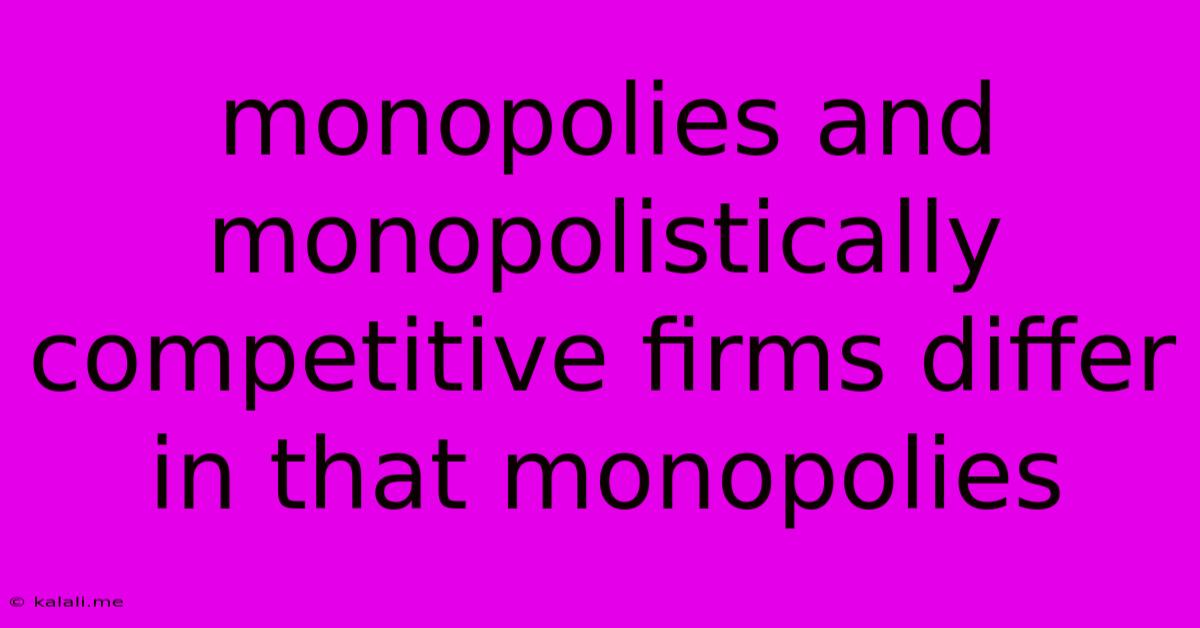Monopolies And Monopolistically Competitive Firms Differ In That Monopolies
Kalali
Jun 12, 2025 · 3 min read

Table of Contents
Monopolies and Monopolistically Competitive Firms: Key Differences
Monopolies and monopolistically competitive firms are both market structures where individual firms have some degree of market power, meaning they can influence the price of their goods or services. However, significant differences exist in the degree of market power, the nature of the products they offer, and the barriers to entry. This article will delve into these key distinctions, explaining how monopolies stand apart from monopolistically competitive firms. The core difference lies in the number of firms and the nature of the product offered.
What is a Monopoly?
A monopoly is a market structure characterized by a single seller offering a unique product with no close substitutes. This single firm holds complete control over the supply of the good or service, allowing it to dictate prices and output levels. Think of utilities like water supply in a specific geographic area; often, only one company provides this service. High barriers to entry prevent other firms from easily competing.
What is Monopolistic Competition?
Monopolistic competition is a market structure where many firms offer similar, but not identical, products. This differentiation might involve branding, marketing, slight variations in product features, or even location. While these firms have some degree of market power due to product differentiation, it's significantly less than that of a monopoly. Think of coffee shops; many exist, each with its unique brand and customer appeal, but all offering essentially the same core product. The barriers to entry are relatively low, allowing new firms to enter the market more easily.
Key Differences between Monopolies and Monopolistically Competitive Firms:
Here's a breakdown of the key distinctions:
1. Number of Firms:
- Monopoly: A single seller dominates the market.
- Monopolistic Competition: Many firms compete within the market.
2. Product Differentiation:
- Monopoly: Offers a unique product with no close substitutes. There's no direct competition.
- Monopolistic Competition: Offers differentiated products; although similar, products have unique features that distinguish them from competitors. This leads to some degree of brand loyalty.
3. Market Power:
- Monopoly: Possesses significant market power, controlling price and output. A monopolist is a price maker.
- Monopolistic Competition: Possesses limited market power; the ability to influence prices is constrained by the presence of many competitors offering similar products. They are more price takers than price makers.
4. Barriers to Entry:
- Monopoly: High barriers to entry exist, preventing new firms from competing. These barriers may include government regulations, patents, control of essential resources, or high start-up costs.
- Monopolistic Competition: Relatively low barriers to entry; new firms can enter the market relatively easily.
5. Long-Run Profitability:
- Monopoly: Can earn long-run economic profits due to the lack of competition.
- Monopolistic Competition: Typically earns zero economic profit in the long run due to the ease of entry. New competitors entering the market erode any above-normal profits.
6. Price and Output:
- Monopoly: Monopolies typically charge higher prices and produce less output compared to a perfectly competitive market, leading to allocative inefficiency.
- Monopolistic Competition: Prices are generally higher than in perfect competition, but output is closer to the perfectly competitive level due to more competition. There is still some level of allocative inefficiency, though less than in a monopoly.
7. Demand Curve:
- Monopoly: Faces a downward-sloping demand curve, reflecting the inverse relationship between price and quantity demanded for its unique product.
- Monopolistic Competition: Also faces a downward-sloping demand curve, but it's more elastic (sensitive to price changes) than a monopoly's demand curve due to the presence of substitutes.
In conclusion, while both monopolies and monopolistically competitive firms deviate from perfect competition, the degree of market power, the nature of the product offered, and the ease of entry distinguish them significantly. Understanding these differences is crucial for analyzing market behavior and the implications for consumers and the economy as a whole. Further research into specific examples of each market structure can enhance this understanding.
Latest Posts
Latest Posts
-
Transitive Verb And Intransitive Verbs Worksheet
Jun 13, 2025
-
Which Of The Following Is A State Function
Jun 13, 2025
-
Which Of The Following Teachers Best Exemplifies Social Constructivist Thinking
Jun 13, 2025
-
Coefficient Of Linear Expansion Of Concrete
Jun 13, 2025
-
Least Common Multiple Of 28 And 35
Jun 13, 2025
Related Post
Thank you for visiting our website which covers about Monopolies And Monopolistically Competitive Firms Differ In That Monopolies . We hope the information provided has been useful to you. Feel free to contact us if you have any questions or need further assistance. See you next time and don't miss to bookmark.